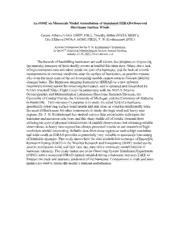
NASA Technical Reports Server (NTRS) 20120002859: An OSSE on Mesoscale Model Assimilation of Simulated HIRAD-Observed Hurricane Surface Winds PDF
Preview NASA Technical Reports Server (NTRS) 20120002859: An OSSE on Mesoscale Model Assimilation of Simulated HIRAD-Observed Hurricane Surface Winds
An OSSE on Mesoscale Model Assimilation of Simulated HIRAD-Observed Hurricane Surface Winds Cerese Albers (NASA GSRP/ FSU), Timothy Miller (NASA MSFC), Eric Uhlhorn (NOAA AOML/HRD), T. N. Krishnamurti (FSU) Abstract Submission for the T. N. Krishnamurti Symposium At the 92nd American Meteorological Society Annual Meeting January 22-26, 2012, New Orleans, LA The hazards of landfalling hurricanes are well known, but progress on improving the intensity forecasts of these deadly storms at landfall has been slow. Many cite a lack of high-resolution data sets taken inside the core of a hurricane, and the lack of reliable measurements in extreme conditions near the surface of hurricanes, as possible reasons why even the most state-of-the-art forecasting models cannot seem to forecast intensity changes better. The Hurricane Imaging Radiometer (HIRAD) is a new airborne microwave remote sensor for observing hurricanes, and is operated and researched by NASA Marshall Space Flight Center in partnership with the NOAA Atlantic Oceanographic and Meteorological Laboratory/Hurricane Research Division, the University of Central Florida, the University of Michigan, and the University of Alabama in Huntsville. This instrument’s purpose is to study the wind field of a hurricane, specifically observing surface wind speeds and rain rates, in what has traditionally been the most difficult areas for other instruments to study; the high wind and heavy rain regions. Dr. T. N. Krishnamurti has studied various data assimilation techniques for hurricane and monsoon rain rates, and this study builds off of results obtained from utilizing his style of physical initializations of rainfall observations, but obtaining reliable observations in heavy rain regions has always presented trouble to our research of high- resolution rainfall forecasting. Reliable data from these regions at such a high resolution and wide swath as HIRAD provides is potentially very valuable to mesoscale forecasting of hurricane intensity. This study shows how the data assimilation technique of Ensemble Kalman Filtering (EnKF) in the Weather Research and Forecasting (WRF) model can be used to incorporate wind, and later rain rate, data into a mesoscale model forecast of hurricane intensity. The study makes use of an Observing System Simulation Experiment (OSSE) with a simulated HIRAD dataset sampled during a hurricane and uses EnKF to forecast the track and intensity prediction of the hurricane. Comparisons to truth and error metrics are used to assess the model’s forecast performance.
